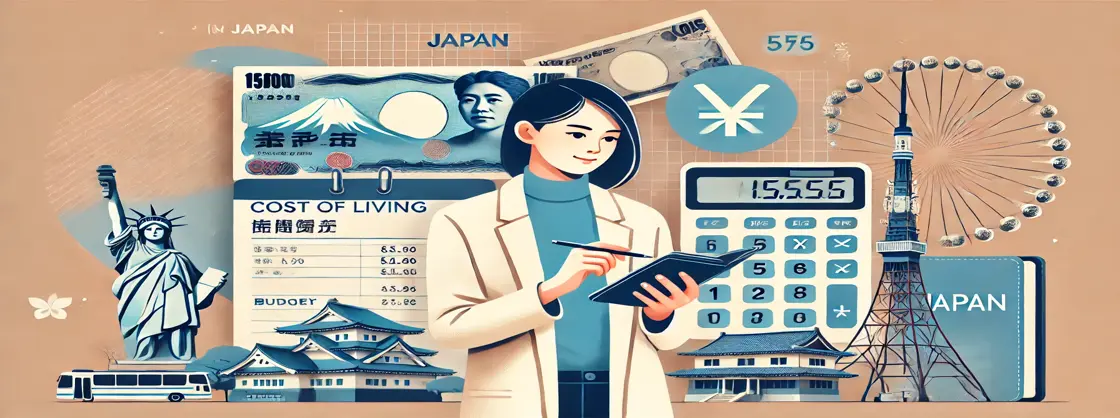Cost of living in Japan for international students (2025-2026)
Table of Contents
Thinking of studying in Japan? You’ve come to the right place! Moving to this fascinating country means more than just experiencing its rich culture and top-tier education; you’ll need to manage your finances effectively to enjoy a seamless study-abroad experience. From bustling Tokyo to serene Kyoto, the cost of living in Japan for international students varies greatly depending on the city, lifestyle choices, and university location.
This blog will walk you through the details of the average living expenses in Japan, including accommodation, food, transportation, utilities, and entertainment costs. Plus, we’ll discuss tuition fees for studying in Japan and ways to optimize your spending. Whether you’re dreaming of exploring Japan’s bustling streets or indulging in its mouthwatering cuisine, budgeting wisely will make your journey stress-free and memorable.
Let’s dive into what makes Japan both affordable and manageable for international students in 2025–2026!
Cost of Living in Japan per Month in 2025-2026
The average cost of living in Japan for international students varies depending on the city, lifestyle, and university location. On average, students should budget between JPY 120,000–150,000 (INR 70,000–90,000) per month. This includes accommodation, food, transport, household bills, and miscellaneous expenses. Major cities like Tokyo and Osaka are more expensive compared to smaller towns. Here’s an overview of the monthly living cost in Japan for international students:
| Expense | Average Monthly Cost (JPY) | Equivalent Cost (INR) (approx.) | Details |
| Accommodation | 30,000–80,000 | 18,000–48,000 | National average: ¥38,000; Tokyo: up to ¥50,000; options include dormitories or private rentals. |
| Food & Groceries | 25,000–40,000 | 15,000–24,000 | Includes meals at home and occasional dining out. Cooking at home is more cost-effective. |
| Transportation | 5,000–15,000 | 3,000–9,000 | Local commute costs; students commuting longer distances may spend more. |
| Utilities | 7,000–12,000 | 4,200–7,200 | Covers electricity, gas, water, and internet bills. |
| Entertainment & Misc. | 6,000–12,000 | 3,600–7,200 | For hobbies, leisure activities, and personal expenses. |
| Total Monthly Cost | 73,000–150,000 | 44,000–90,000 | Varies based on lifestyle, city, and accommodation type. |
Notes:
- Tokyo and Osaka tend to be more expensive than smaller cities like Kyoto or Fukuoka.
- Many students can save on transportation costs by choosing university dormitories located near campus.
- Proper budgeting and opting for shared accommodation or student dorms can significantly reduce monthly expenses.
Accommodation cost in Japan in 2025- 2026
When planning to study in Japan for the 2025–2026 academic year, it’s essential to understand the expected accommodation costs, as they can vary significantly based on location, type of housing, and personal preferences. Here’s a detailed breakdown to help you budget effectively:
Types of Accommodation in Japan:
- University Dormitories: Many Japanese universities offer on-campus housing, which is often more affordable and provides a community atmosphere. However, availability is limited, and rooms are allocated on a first-come, first-served basis.
- Private Apartments: Opting for a private apartments in Japan offers more independence but comes with higher costs and additional expenses such as security deposits and utility fees.
- Shared Housing (Guesthouses/Share Houses): These are popular among international students for their balance between cost and social interaction. Residents have private rooms but share common areas like kitchens and living spaces.
Average Monthly Rent by Region:
Accommodation costs in Japan vary by region. Below is a table summarizing the average monthly rent for international students in Japan different areas:
| Region | Average Monthly Rent (JPY) | Details |
| National Average | ¥38,000 | General average across Japan. |
| Tokyo | ¥50,000–¥70,000 | Higher costs due to urban location; apartments may range from ¥50,000 to ¥70,000 per month. |
| Kanto Region | ¥44,000 | Includes areas surrounding Tokyo; slightly lower than the capital. |
| Kinki Region | ¥37,000 | Cities like Osaka and Kyoto; more affordable than Tokyo. |
| Chubu Region | ¥29,000 | Central Japan; offers a balance between urban and rural living costs. |
| Kyushu Region | ¥26,000 | Southern Japan; among the more affordable regions for students. |
Initial Move-in Costs in Japan:
When renting a private apartment, be prepared for upfront expenses, which may include:
- Security Deposit (Shiki-kin): Typically, equivalent to 1–2 months’ rent; refundable upon move-out if there is no damage.
- Key Money (Rei-kin): A non-refundable gratuity fee to the landlord, often amounting to 1–2 months’ rent.
- Agent Fees: If using a real estate agent, expect to pay a commission fee, usually around one month’s rent.
Transportation price in Japan in 2025-2026
Transportation in Japan is efficient and reliable, but costs can vary depending on the city and the mode of transport. International students should budget for daily commuting, occasional travel, and leisure trips. Here’s a detailed overview of transportation prices in Japan for 2025–2026:
Monthly Transportation Costs in Japan
Transportation costs depend on the city size and distance traveled. Below are typical monthly expenses for students:
| Mode of Transport | Average Monthly Cost (JPY) | Details |
| Local Trains/Metro | ¥5,000–¥15,000 | Ideal for daily commutes; costs depend on the city and distance. |
| Buses | ¥4,000–¥8,000 | Common in smaller towns or areas not served by trains. |
| Bicycles (Owned or Rented) | ¥500–¥3,000 | A budget-friendly and eco-friendly alternative for short commutes. |
Regional and National Travel Costs in Japan
Japan’s extensive public transport network makes it easy to travel between cities. Here are expected costs for intercity travel:
| Mode of Transport | Average Cost (JPY) | Details |
| Shinkansen (Bullet Train) | ¥8,000–¥15,000 | One-way tickets for Tokyo to Osaka or similar routes. |
| Highway Buses | ¥3,000–¥6,000 | A budget-friendly option for long-distance travel. |
| Domestic Flights | ¥5,000–¥15,000 | Discounted fares available through low-cost carriers like Peach or Jetstar. |
Tips to Save on Transportation Costs
- Buy a Commuter Pass: If you frequently travel between two points, commuter passes offer significant savings.
- Use IC Cards: Cards like Suica and Pasmo offer discounted fares on trains, buses, and even vending machines.
- Opt for Bicycles: Ideal for short commutes and small towns; cycling is common and cost-effective.
- Plan Long-Distance Travel: Book highway buses or flights in advance for discounts.
- Share Rides: Use carpooling apps or shared taxi services for occasional trips.
Transportation Costs in Major Cities
Costs vary by city. Here’s a quick snapshot of typical monthly transportation expenses in key locations:
| City | Average Monthly Cost (JPY) | Details |
| Tokyo | ¥10,000–¥15,000 | Extensive metro and bus networks; slightly higher fares. |
| Osaka | ¥8,000–¥12,000 | Affordable subway and bus system. |
| Kyoto | ¥6,000–¥10,000 | Primarily buses; discounted passes are available. |
| Fukuoka | ¥5,000–¥8,000 | Compact city with efficient local transport. |
Food and grocery prices in Japan in 2025-2026
Food and grocery costs in Japan are a significant part of an international student’s budget. Japan offers a variety of options, from affordable local meals to more expensive imported groceries. For the 2024–2025 academic year, here’s a detailed breakdown of what students can expect for food and grocery expenses:
Average Monthly Food Costs in Japan 2025-2026
The cost of food depends on whether you prefer to cook at home or eat out frequently. Here’s a rough estimate of monthly food expenses in Japan for international students in 2025:
| Expense | Average Monthly Cost (JPY) | Details |
| Cooking at Home | ¥25,000–¥35,000 | Covers groceries like rice, vegetables, meat, fish, eggs, and condiments. |
| Eating Out Occasionally | ¥30,000–¥45,000 | Includes a mix of home-cooked meals and occasional affordable restaurant visits. |
| Frequent Dining Out | ¥45,000–¥60,000 | Suitable for those who rely mostly on restaurants or convenience stores. |
Grocery Prices in Japan
For those who plan to cook at home, groceries can be affordable, especially if you buy locally produced items. Imported goods, however, are relatively expensive. Here’s a snapshot of grocery prices in Japan in 2025:
| Grocery Item | Average Price (JPY) | Details |
| Rice (5kg) | ¥1,800–¥2,500 | A staple food in Japan, perfect for budgeting students. |
| Fresh Vegetables (per kg) | ¥200–¥400 | Costs vary based on the season and type (e.g., cabbage, spinach). |
| Chicken (1kg) | ¥600–¥1,000 | Affordable protein source compared to beef or pork. |
| Fish (per kg) | ¥1,000–¥2,500 | Seafood is a dietary staple, especially in coastal areas. |
| Eggs (10-pack) | ¥200–¥300 | A versatile and inexpensive protein option. |
| Milk (1L) | ¥150–¥200 | Regularly consumed with cereal or tea. |
| Bread (Loaf) | ¥150–¥250 | Perfect for quick breakfasts or snacks. |
| Instant Noodles (Pack) | ¥120–¥200 | A quick and affordable option for students in a rush. |
Tips to Save on Food Costs in Japan 2025
- Shop at Discount Stores: Stores like Don Quijote and Gyomu Super offer affordable groceries.
- Buy Local and Seasonal: Fresh produce and fish are cheaper when in season and locally sourced.
- Student Discounts: Some restaurants near universities offer discounts to students.
- Cook in Batches: Preparing meals in advance can save time and money.
- Convenience Store Deals: While more expensive than cooking, many stores offer discounted prices on bento boxes after certain hours.
Expected Cost of Studying in Japan (2025–2026)
Studying in Japan offers international students a chance to experience top-tier education, cultural immersion, and cutting-edge research opportunities. However, the cost of studying in Japan varies depending on the university, program type, and additional expenses like admission fees, tuition, and course materials.
Tuition Fees for Universities in Japan 2025-2026
Tuition fees in Japan depend on whether you enroll in national, public, or private universities. Here’s a breakdown:
| Type of University | Annual Tuition Fees (JPY) | Annual Tuition Fees (INR) | Details |
| National Universities | ¥535,800 – ¥700,000 | ₹3,20,000 – ₹4,20,000 | Set by the government, offering quality education at lower costs. |
| Public Universities | ¥600,000 – ¥900,000 | ₹3,60,000 – ₹5,40,000 | Slightly more expensive but still affordable compared to private universities. |
| Private Universities | ¥1,200,000 – ¥1,800,000 | ₹7,20,000 – ₹10,80,000 | Varies significantly based on the program, with medical and engineering programs costing more. |
Scholarships for International Students in Japan 2025
Japan offers various scholarships to ease the financial burden for international students:
| Scholarship Name | Annual Coverage (JPY) | Details |
| MEXT (Monbukagakusho) | ¥117,000 – ¥145,000/month | Covers tuition, admission fees, and monthly stipend. |
| JASSO Scholarship | ¥48,000/month | Financial aid for students demonstrating academic excellence. |
| University-Specific Scholarships | Varies | Offered by individual universities for tuition discounts or stipends. |
Comparison of Study Costs for Popular Courses
Different programs in Japan come with varying costs. Here’s an estimate of tuition fees for popular courses in Japan:
| Program | Annual Tuition Fees (JPY) | Annual Tuition Fees (INR) | Details |
| Humanities and Social Sciences | ¥500,000 – ¥800,000 | ₹3,00,000 – ₹4,80,000 | Includes courses like Economics, History, and Political Science. |
| Engineering and Technology | ¥700,000 – ¥1,200,000 | ₹4,20,000 – ₹7,20,000 | Higher due to laboratory and material costs. |
| Medical and Healthcare | ¥1,500,000 – ¥2,500,000 | ₹9,00,000 – ₹15,00,000 | The most expensive due to lab equipment and clinical practice. |
| Art and Design | ¥800,000 – ¥1,300,000 | ₹4,80,000 – ₹7,80,000 | Includes costs for art supplies and studio access. |
Conclusion
Living and studying in Japan is undoubtedly a transformative experience. While the cost of living in Japan for international students might seem daunting at first, with careful planning and budgeting, it’s absolutely manageable. Whether you’re saving money by sharing accommodation or taking advantage of scholarships like MEXT or JASSO, there are plenty of ways to ease the financial burden.
From reasonably priced meals at local eateries to the convenience of Japan’s world-class transportation system, every yen spent contributes to an enriching study-abroad journey. By understanding the average living expenses in Japan, including tuition fees, food, accommodation, and more, you’ll be fully equipped to plan your adventure effectively.
So, what are you waiting for? Begin your Japanese adventure today—immerse yourself in the culture, embrace the academics, and create unforgettable memories while staying financially savvy. Japan is ready for you!
Frequently Asked Questions
Is Japan affordable for international students?
Yes, Japan is relatively affordable compared to countries like the US and UK. Many universities offer scholarships and tuition exemption/reduction programs, making it easier for international students to manage expenses.
How much money do students need to live in Japan?
Living costs depend on lifestyle and location. On average, international students need around $1,500 to $2,000 per month to cover basic expenses like rent, food, and transportation. In regions like Yamanashi, living costs can be as low as 88,330 JPY per month, including essentials such as rent, meals, and health insurance.
How much does rent cost in Japan per month?
Rent in Japan varies by location and housing type.
- Shared rooms: ~20,000 JPY (190 USD) per month.
- Private apartments: ~150,000 JPY (1,400 USD) per month in cities like Tokyo.
- Two-bedroom units: ~200,000 JPY (1,870 USD) per month.
How much can students earn in Japan?
International students can earn between 898 JPY (Yamanashi’s minimum wage) to 1,500 JPY per hour, depending on the job type and location. Part-time work is a popular way for students to cover living expenses while studying.





